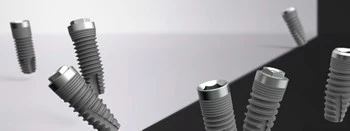dental implants
All-On-4 after 5 Years
A group of dental researcher from Italy conducted a clinical study with 5-year follow up to evaluate the use of prefabricated bar for All-on-4, immediate-loading implants in edentulous patients. Prior to surgery by 1 hour, the patients received 2 g amoxicillin; then they were prescribed 1 g twice daily for 1 week after surgery. In …
Future Application of PEEK as Dental Implants
PEEK (polyetheretherketone) is a semi-crystalline linear polycyclic thermoplastic material which is considered as a strong biomaterial. It can be applied in dental implants as implant superstructure, abutment or body. There is current research on reinforcing PEEK material by additives and surface modifications. PEEK is a dominant of PAEK (poly-aryl-ether-ketone) polymers that possess high thermal stability …
Continue reading “Future Application of PEEK as Dental Implants”
Ceramic Sprays For Titanium Implant Abutments and Ceramic Restorations
Thanks for Contribution by Phillip G. Pitts Sr. Enamelite LLC Initial: 2. Sandblast (120 um); Steam Clean; Air Oxidize 3. Ti Bonder and Opaque Application Technique: Always use a analog holder through all steps to apply ceramic. Prepare titanium surface to receive ceramic use a Clean Crosscut carbide bur. Sandblast surface with minimum 120-150 micron aluminous …
Continue reading “Ceramic Sprays For Titanium Implant Abutments and Ceramic Restorations”
Ready to Use Titanium-Based Nanostructures for Dental Implants
Titanium alloys have excellent mechanical properties, corrosion resistance and biocompatibility, but their usage as dental implants is compromised by bacterial growth causing infection, inflammation and peri-implantitis. The infection process starts with the formation of bacterial biofilms, that is, bacteria accumulate over the implant’s surfaces and form a matrix of extracellular polymeric substances to protect themselves …
Continue reading “Ready to Use Titanium-Based Nanostructures for Dental Implants”
Adapting Gingival Grafting Surgeries
Osteo-integration of dental implants is not the only factor for successful implant procedure. Maintaining soft-tissue profile and interdental papillae are also responsible for establishing stable, esthetic results of implants; and failure to restore soft tissues around the implant(s) contributes to functional, esthetic and even phonetic complications in addition to hygienic challenges and future recession. Maintaining …
Antibiotic Prophylaxis for Major Dental Surgeries
Antibiotic resistance is among the most prominent health threats worldwide in the recent years. About 10% of antibiotics which are prescribed in dental clinics nowadays are considered unnecessary. Worldwide, evidence has shown that 58%–81% of prophylactic dental antibiotic prescriptions are inconsistent with community/international guidelines. Dentists must acknowledge the indications for dental antibiotics, especially when prescribed …
Continue reading “Antibiotic Prophylaxis for Major Dental Surgeries”






